In today’s fast-paced world, maintaining heart health is more crucial than ever. One of the most important — yet often misunderstood — factors in cardiovascular wellness is cholesterol. While many people assume all cholesterol is harmful, the truth is more nuanced. The body produces two types: good cholesterol and bad cholesterol. Understanding the difference between them is essential if you want to effectively manage and improve your overall heart health.
Good cholesterol, known as HDL (high-density lipoprotein), helps treat cholesterol problems by removing excess fat from your arteries and transporting it to the liver for elimination. On the other hand, bad cholesterol — or LDL (low-density lipoprotein) — contributes to plaque buildup in arteries, increasing the risk of heart attack and stroke.
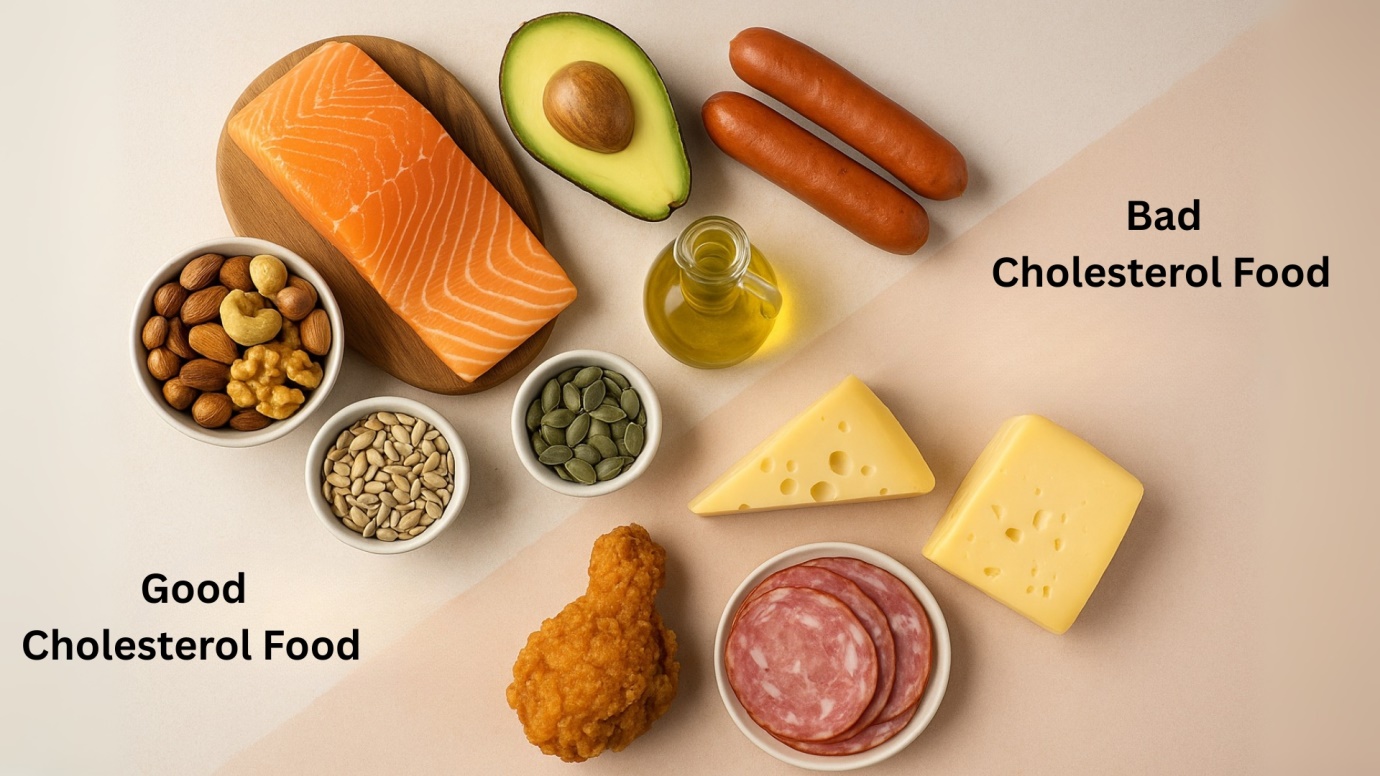
The good news? You can influence your cholesterol levels significantly through dietary and lifestyle choices. Certain cholesterol foods — such as processed meats, fried snacks, and high-fat dairy — can raise bad cholesterol, while good cholesterol foods like oats, nuts, fatty fish, and olive oil help boost your HDL levels and control of cholesterol naturally.
By making smarter food choices and adopting heart-friendly habits, you can treat cholesterol without medication and reduce long-term health risks. This blog will guide you through which foods help and which ones harm, empowering you to take charge of your health with science-backed insights on cholesterol foods and smart nutrition.
What Is Cholesterol?
Cholesterol is a waxy, fat-like substance found in every cell of your body. Despite its negative reputation, cholesterol plays a vital role in several biological processes. It helps build cell membranes, produces essential hormones like estrogen and testosterone, and is required for your body to make vitamin D. It also supports the production of bile acids, which are crucial for digesting dietary fats, including those found in various cholesterol foods.
Cholesterol Transport in the Body
Because cholesterol doesn’t dissolve in water, it cannot travel through the bloodstream on its own. Instead, it binds to special particles called lipoproteins, which act like delivery vehicles. These lipoproteins determine how cholesterol is distributed and used in your body, and ultimately influence whether it helps or harms your heart.
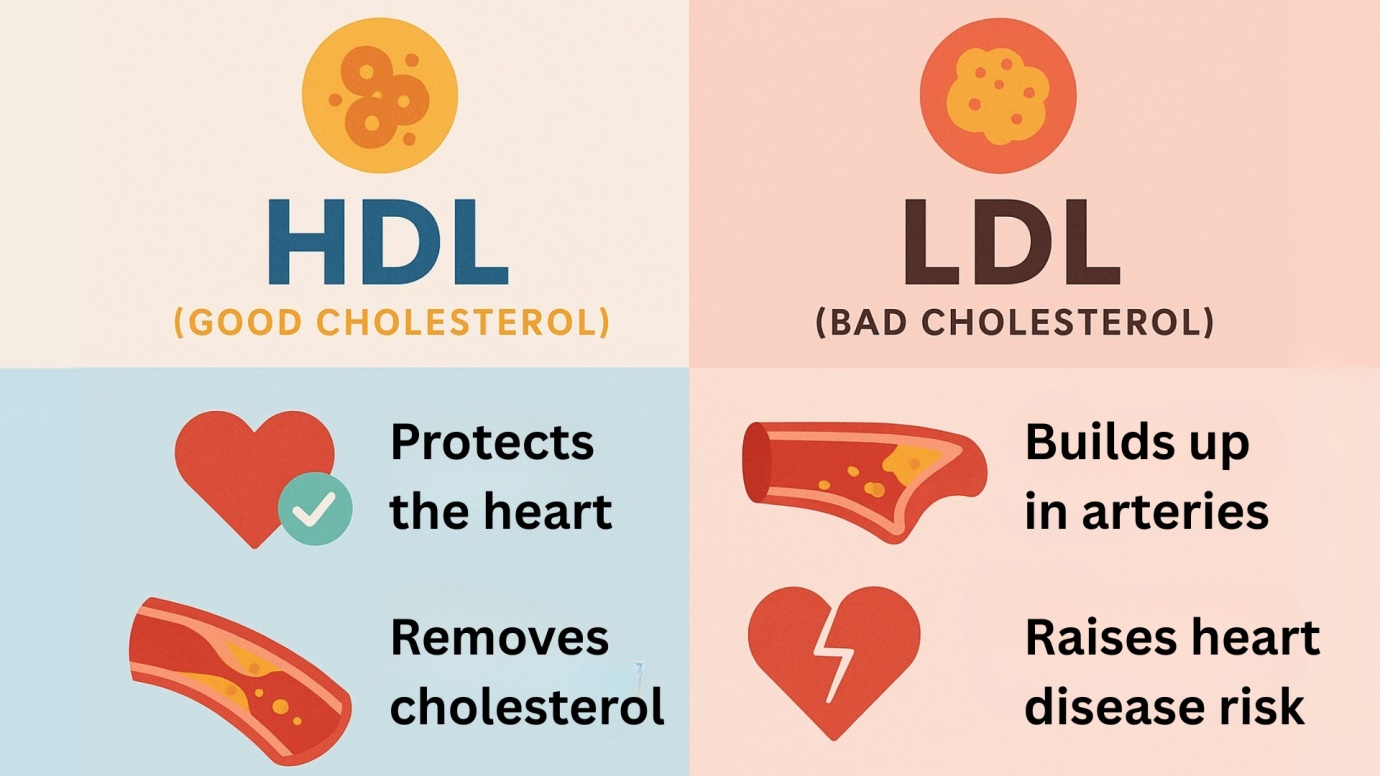
Types of Cholesterol: HDL and LDL
HDL – Good Cholesterol
HDL (High-Density Lipoprotein) is often referred to as good cholesterol. Why? Because it works like a vacuum, removing excess cholesterol from your bloodstream and transporting it back to the liver for disposal. Higher levels of HDL are associated with a lower risk of heart disease, which makes foods rich in HDL cholesterol and food for HDL vital components of a heart-healthy diet.
To improve your HDL levels, include good cholesterol foods like:
- Fatty fish (salmon, sardines)
- Avocados
- Olive oil
- Nuts and seeds
These foods rich in HDL cholesterol not only boost your HDL but also support overall control of cholesterol in the body.
LDL – Bad Cholesterol
LDL (Low-Density Lipoprotein), on the other hand, is labeled as bad cholesterol due to its harmful effects on heart health. When too much LDL circulates in your blood, it can stick to the walls of your arteries, leading to plaque buildup — a condition known as atherosclerosis. This can increase the risk of heart attacks, strokes, and other cardiovascular diseases. Individuals with high LDL levels should pay close attention to their diet and limit harmful cholesterol foods such as processed meats, fried items, and full-fat dairy products.
Understanding the difference between good cholesterol and bad cholesterol is essential for anyone looking to improve their heart health. Your goal should be to raise HDL and lower LDL through diet, lifestyle, and physical activity. Consuming more good cholesterol foods and reducing intake of harmful cholesterol foods is one of the most effective ways to promote the control of cholesterol naturally.
Why Does Cholesterol Matter for Heart Health?
Cholesterol levels play a crucial role in cardiovascular health. While your body needs some cholesterol to function properly, an imbalance between good cholesterol and bad cholesterol can significantly increase the risk of serious heart-related conditions. Understanding the difference between LDL cholesterol and HDL cholesterol — and how they impact your arteries — is key to preventing long-term health complications.
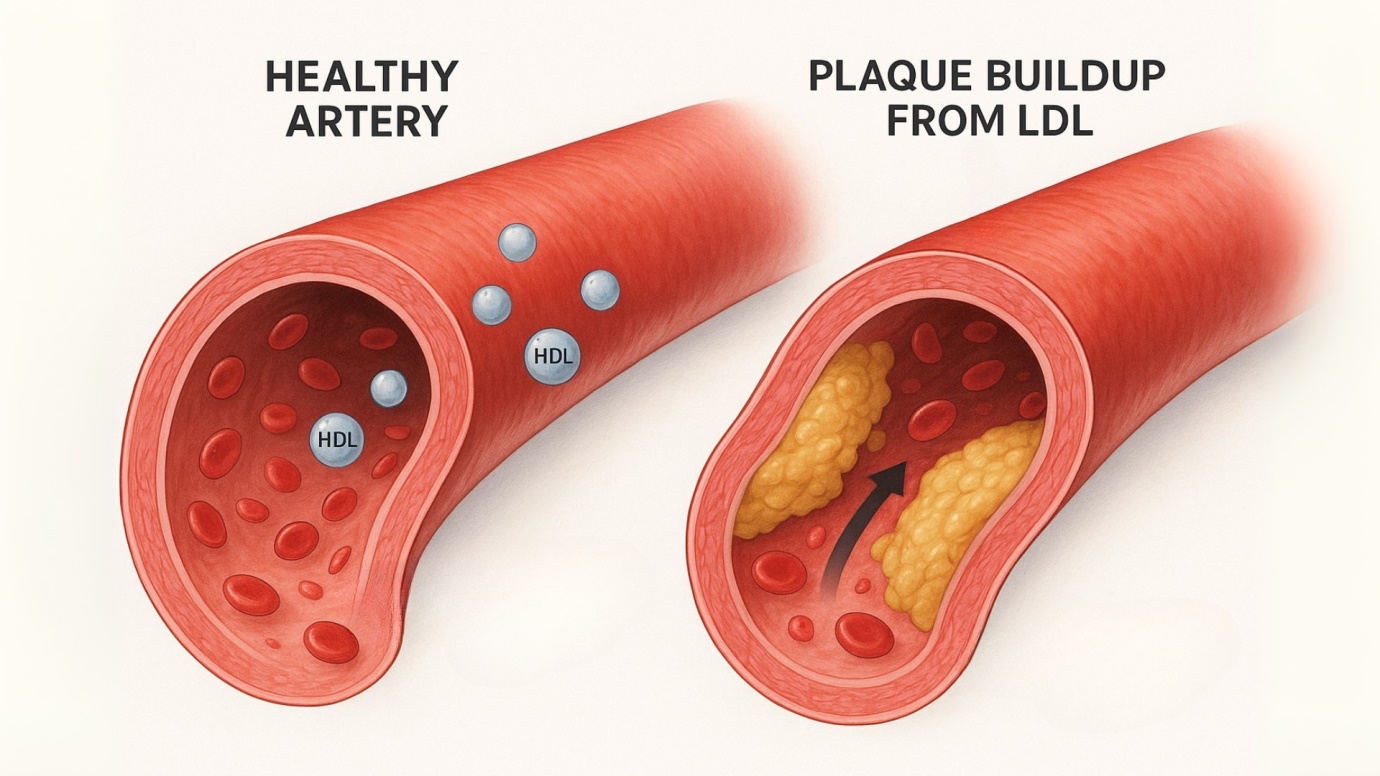
The Danger of Bad Cholesterol and Artery Plaque
LDL cholesterol, or Low-Density Lipoprotein, is commonly known as bad cholesterol. It becomes dangerous when there’s too much of it in your bloodstream. Excess LDL deposits fat on the inner walls of arteries, leading to the formation of plaque — a sticky, waxy buildup that causes arteries to narrow and harden.
This condition, called atherosclerosis, limits blood flow and increases the likelihood of:
- Heart attacks
- Strokes
- Peripheral artery disease
- High blood pressure
People with high LDL are at a significantly greater risk of cardiovascular events. That’s why it’s essential to adopt dietary habits that include foods to lower bad cholesterol, such as oats, legumes, nuts, and fatty fish.
Good Cholesterol: The Heart’s Natural Defense
In contrast, good cholesterol — scientifically known as HDL (High-Density Lipoprotein) — acts as a natural protector of the heart. It helps clear the bloodstream of excess LDL by transporting it back to the liver, where it can be broken down and eliminated.
Eating foods rich in HDL cholesterol is one of the most effective ways to strengthen this protective mechanism. Excellent food for HDL includes:
- Fatty fish like salmon and sardines
- Chia seeds and flaxseeds
- Olive oil and avocado
- Nuts such as almonds and walnuts
Incorporating these foods rich in HDL cholesterol into your daily meals helps balance cholesterol levels and shields the heart from inflammation and oxidative stress.
Maintaining a healthy cholesterol balance through nutrition — especially by prioritizing foods to lower bad cholesterol and increasing food for HDL — is one of the most natural and powerful strategies for heart protection.
Foods That Help Your Heart (Raise Good Cholesterol / Lower Bad)
A heart-healthy diet is one of the most effective strategies to lower cholesterol naturally, reduce inflammation, and support your cardiovascular system. By focusing on good cholesterol foods and avoiding harmful fats, you can improve your lipid profile significantly. This section explores the best foods to reduce cholesterol, especially those that boost HDL and suppress LDL levels.
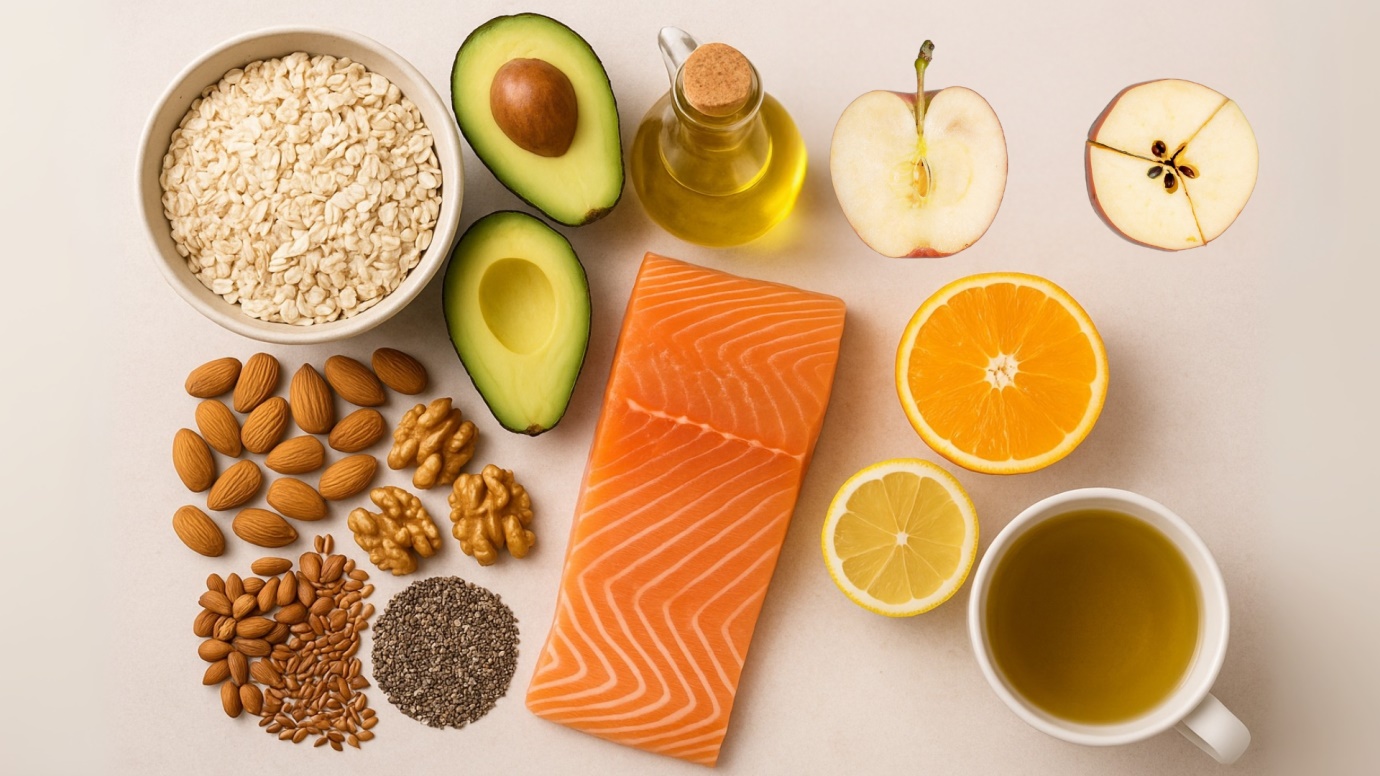
Soluble Fiber Heroes
Soluble fiber is one of the most powerful cholesterol fighting foods available in nature. It binds to LDL particles in the digestive tract, reducing their absorption and helping to flush them out of the body.
Top soluble fiber-rich foods include:
- Oats – the classic cholesterol busting food
- Lentils and beans
- Fruits such as apples, oranges, berries, and pears
These foods are excellent foods to reduce cholesterol, especially as part of an Indian vegetarian diet. They serve as the foundation of a cholesterol control food plan and are among the best foods to reduce cholesterol overall.
Healthy Fats: Monounsaturated & Polyunsaturated
Healthy fats not only lower LDL but also raise HDL, making them vital foods to eat for good cholesterol. These fats are found in:
- Avocados
- Olive oil
- Nuts (especially almonds, walnuts, and peanuts)
- Seeds (sunflower, flax, chia)
- Fatty fish (like salmon and sardines)
These are perfect examples of foods rich in HDL cholesterol. Regular consumption helps improve your overall lipid profile and promotes ldl control food choices. In fact, peanut is good for cholesterol due to its high monounsaturated fat content.
Omega-3 Rich Foods
Omega-3 fatty acids are powerful ldl reducing foods that also support heart rhythm and reduce inflammation.
Top sources include:
- Salmon
- Mackerel
- Chia seeds
- Flaxseeds
These omega-3 foods are considered good food to reduce cholesterol and are especially beneficial for people seeking natural remedies to lower cholesterol.
Plant Sterols & Stanols
Plant sterols and stanols are compounds naturally found in plants that help block the absorption of cholesterol in the intestines.
Best sources:
- Fortified foods (like some juices and spreads)
- Sesame seeds
- Wheat bran
Including these in your daily diet provides an excellent food to lessen cholesterol and is highly recommended as a cholesterol control food option.
Antioxidant Fruits & Green Tea
Antioxidants can prevent the oxidation of LDL cholesterol, which is a key contributor to arterial plaque.
Top choices:
- Berries (blueberries, strawberries)
- Grapes
- Citrus fruits (oranges, lemons)
- Green tea
These are the best fruits to lower cholesterol, and each is considered a fruit that reduces cholesterol. Regular intake of these antioxidants enhances HDL function and helps lower cholesterol naturally.
BONUS: Garlic, Dairy & Practical Tips
- Garlic for cholesterol: Research shows that aged garlic extract may reduce LDL and total cholesterol. Indeed, garlic can reduce cholesterol when used consistently in cooking.
- Milk and cholesterol: Opt for low-fat or plant-based alternatives like almond or oat milk to avoid saturated fats.
- To reduce cholesterol what to eat? Stick to high-fiber, plant-based, and oily fish-rich diets, along with foods good for high cholesterol like nuts, whole grains, and leafy greens.
Foods That Harm Your Heart (Raise Bad Cholesterol / Lower Good Cholesterol)
While some foods help promote heart health, others have the opposite effect — raising bad cholesterol, lowering HDL (good cholesterol), and increasing the risk of heart disease, stroke, and high blood pressure. These foods to avoid for cholesterol not only damage your arteries but also make it harder to manage your overall lipid profile.
Let’s look at the most common bad cholesterol food groups that you should minimize or eliminate from your diet.
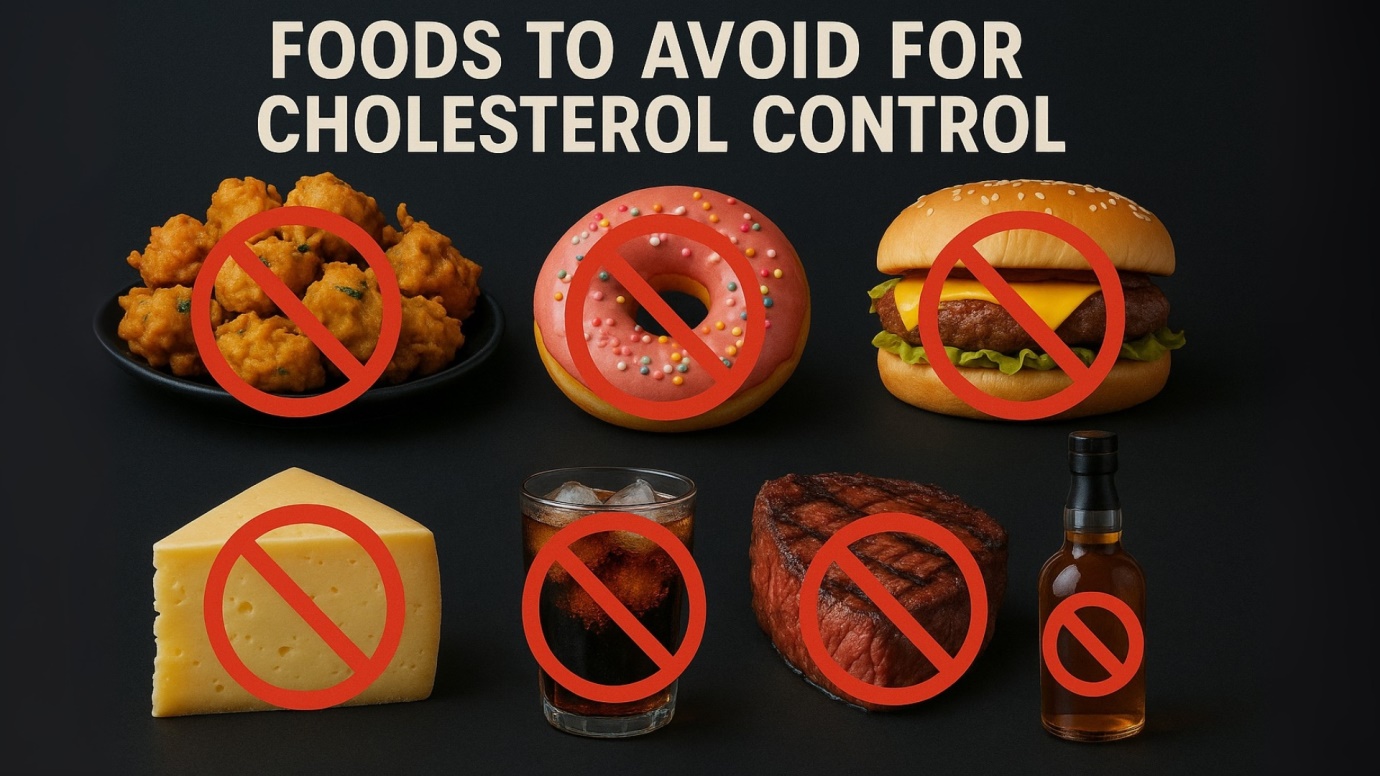
Trans Fats – The Silent Killer
Trans fats are among the most dangerous foods that higher cholesterol. They raise LDL (bad cholesterol) while simultaneously lowering HDL (good cholesterol) — a double threat to heart health.
Common sources of trans fats include:
- Packaged snacks (biscuits, cookies, pastries)
- Fried food (samosas, pakoras, French fries)
- Fast food (burgers, fried chicken)
These are clear examples of foods not to eat for cholesterol, as they contribute significantly to artery-clogging plaque. Trans fats are also found in some commercially baked goods under the label “partially hydrogenated oils,” making them hidden high cholesterol foods to eat with caution.
Saturated Fats
While small amounts of saturated fats can be part of a balanced diet, excess intake leads to elevated LDL levels, making them a major category of foods with high cholesterol level.
Top sources include:
- Butter and ghee
- Fatty cuts of red meat
- Full-fat dairy
- Coconut oil (use in moderation)
These are foods that higher cholesterol and should be eaten sparingly, especially by those with a family history of heart disease or those trying to lower LDL naturally. Replacing them with unsaturated fats can lead to significant improvement in your lipid profile.
Processed & Fast Foods
Processed meats and fast foods are often high in saturated fat, sodium, and preservatives — making them some of the worst bad cholesterol food offenders.
Avoid or limit foods like:
- Sausages
- Pizzas with processed meats
- Fried snacks (nuggets, patties, kachoris)
These are foods not to eat with high cholesterol, especially if you’re already struggling with poor heart markers. These options qualify as major foods to avoid for cholesterol control.
Excess Sugar & Refined Carbs
Although sugar doesn’t contain cholesterol, diets high in sugar and refined carbs increase triglycerides and lower HDL, indirectly making them foods that higher cholesterol risks.
Key culprits:
- Soft drinks and sugary beverages
- White bread and refined flour items
- Sweets and desserts
These are foods increase cholesterol indirectly by altering fat metabolism and promoting weight gain, which worsens your overall cholesterol profile. They should be limited in any plan to reduce high cholesterol foods to eat regularly.
Alcohol (Excessive Use)
Moderate alcohol consumption may have minimal HDL benefits, but excessive drinking leads to raised triglycerides, liver stress, and lowered HDL levels.
Chronic alcohol consumption is one of the most overlooked foods not to eat for cholesterol control, especially in the Indian context where binge drinking is common during social events.
Cutting back or abstaining is often necessary for individuals aiming to manage foods with high cholesterol level and restore balance between LDL and HDL.
Smart Cholesterol-Friendly Food Swaps
Making simple food substitutions can go a long way in managing your cholesterol levels. By replacing harmful ingredients with nutrient-rich alternatives, you not only lower bad cholesterol but also improve your levels of good cholesterol — supporting overall heart health.
These smart swaps are ideal for anyone looking to adopt foods to cut cholesterol, promote the control of cholesterol, and build a sustainable, heart-healthy lifestyle.
Instead of… | Try… | Why it works |
Butter | Olive oil | Swap butter for olive oil to cut saturated fat and boost heart health. Olive oil raises good (HDL) cholesterol and lowers bad (LDL). |
White rice | Brown rice, quinoa | Swap white rice for brown rice or quinoa to boost fiber, manage cholesterol, and support heart health. |
Sugary drinks | Lemon water, green tea | Replace sugary drinks with lemon water or green tea. They cut sugar, boost antioxidants, and help lower bad cholesterol while protecting heart health. |
Chips | Nuts or seeds | Swap fried snacks for nuts or seeds to avoid trans fats and boost heart-healthy fats and fiber. |
These are among the best good cholesterol foods, known to increase HDL and help in the treat cholesterol process naturally. In fact, just a handful of nuts daily is considered a powerful tool in managing cholesterol foods to eat wisely.
Making small, mindful changes to your daily meals can transform your health. By incorporating these swaps into your diet, you reduce your intake of harmful cholesterol foods and move toward a lifestyle that promotes more good cholesterol and better cardiovascular well-being.
Sample Day of Heart-Healthy Eating (Indian Style Option)
Eating right is one of the most powerful ways to maintain the control of cholesterol, reduce high LDL, and promote overall cardiovascular well-being. If you’re looking for foods to eat with high cholesterol, this Indian-style day plan offers a balanced, delicious, and heart-healthy routine. It includes a combination of cholesterol foods that support good cholesterol levels while reducing harmful fats.
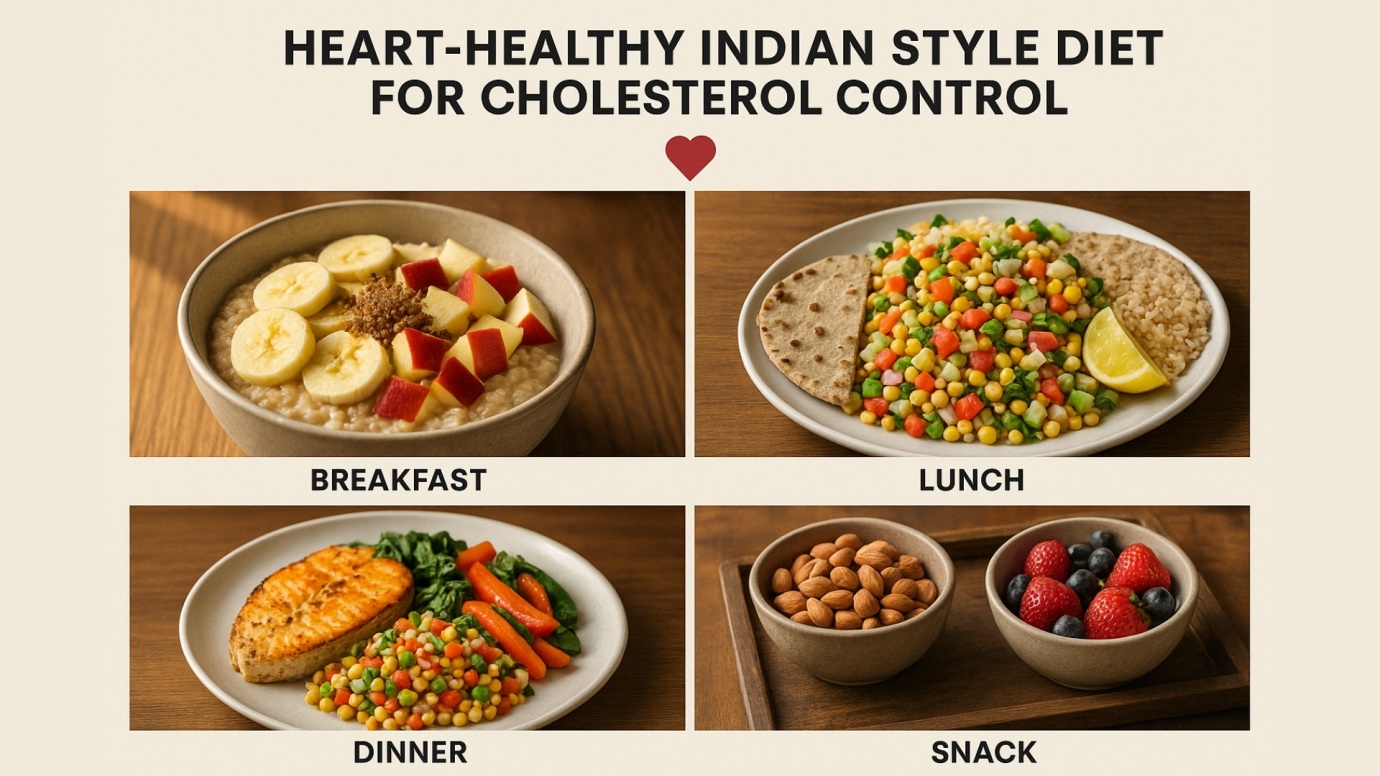
Note: This information is provided for general guidance only. Always consult a healthcare professional for personalized nutrition advice.
Breakfast: Oats with Fruits & Flaxseeds
Start your day with a bowl of oats topped with fresh fruits (like bananas or apples) and a spoonful of ground flaxseeds.
- Oats are rich in soluble fiber, which helps reduce high LDL by trapping cholesterol in the digestive tract.
- Flaxseeds are a great food for HDL, packed with omega-3 fatty acids.
- Fruits add antioxidants and natural sweetness, contributing to good cholesterol foods.
This breakfast is a perfect example of foods to eat with high cholesterol, as it not only fills you up but actively helps to lower bad fats in the blood.
Lunch: Mixed Lentil Salad + Whole Grains
For lunch, enjoy a colorful mixed lentil salad with chopped cucumbers, tomatoes, onions, lemon juice, and a touch of olive oil. Pair it with brown rice or millet roti for a hearty meal.
- Lentils are low in saturated fat and high in fiber, making them top-tier cholesterol foods for vegetarians.
- Whole grains support digestion and help in the control of cholesterol.
- Olive oil adds healthy monounsaturated fats — one of the best foods rich in HDL cholesterol.
This is a fulfilling meal packed with plant-based protein and heart-protective ingredients.
Dinner: Grilled Fish or Tofu + Veggies
Dinner should be light yet nutritious. Opt for grilled fish (like rohu or salmon) or tofu for vegetarians. Serve it with steamed or sautéed vegetables such as spinach, bell peppers, and carrots.
- Fatty fish is a powerful food for HDL, loaded with omega-3s and protein.
- Tofu, made from soy, is also a proven good cholesterol food
- Vegetables are fiber-rich and help flush out bad cholesterol from your system.
This balanced plate is rich in nutrients, low in saturated fat, and ideal for those aiming to lower high LDL naturally.
Snack: Roasted Peanuts + Berries
Between meals or in the evening, enjoy a light snack of roasted peanuts with a handful of berries (such as strawberries or blueberries).
- Peanut is a good choice for cholesterol because it contains heart-healthy fats and plant-based protein.
- Berries are antioxidant-rich and can improve the functionality of good cholesterol.
- Together, they make an excellent addition to your list of foods to eat with high cholesterol.
This snack not only satisfies hunger but also delivers key nutrients to support lipid balance.
FAQs
Q1. What is the difference between good cholesterol and bad cholesterol?
- Good cholesterol (HDL) helps remove excess cholesterol from your blood vessels, while bad cholesterol (LDL) can build up in your arteries and increase heart disease risk. Balancing both is essential for the control of cholesterol.
Q2. Are there specific foods to lower cholesterol that I should eat daily?
- Yes, daily foods to lower cholesterol include nuts, seeds, beans, green tea, and whole grains. These help in the effective treat cholesterol process.
Q3. What are good cholesterol foods I can include in Indian meals?
- Popular Indian good cholesterol foods are rajma, chana, moong dal, groundnuts, flaxseeds, and mustard oil in moderation. These are excellent foods to eat with high cholesterol.
Q4. What cholesterol foods should I avoid completely?
- Limit cholesterol foods like fried snacks, processed meats, full-fat dairy, and sugary desserts. These are bad cholesterol food that contribute to heart disease.
Q5. Can milk increase cholesterol levels?
- Full-fat milk and cholesterol are linked due to saturated fat. Switch to low-fat or plant-based options to help with control of cholesterol.
Q6. What foods increase cholesterol the most?
- Foods that higher cholesterol include trans fats, deep-fried items, red meat, and baked goods with hydrogenated oils — all contributors to bad cholesterol.
Q7. How can I reduce high LDL through diet?
- You can reduce high LDL by eating ldl reducing foods like oats, barley, nuts, and soy. These also support the rise of good cholesterol.
Q8. Is garlic helpful for cholesterol management?
- Yes, studies suggest that garlic for cholesterol can help lower LDL levels. It’s a simple, natural ingredient to include when trying to treat cholesterol.
Q9. Are fruits helpful in lowering cholesterol?
- Absolutely. Fruits to lower cholesterol include apples, oranges, berries, and grapes. Each is a fruit that reduces cholesterol by providing fiber and antioxidants.
Q10. What’s an easy Indian-style meal plan for someone with high cholesterol?
- Start with oats for breakfast, have lentils and whole grains for lunch, grilled fish or tofu with veggies for dinner, and snacks like peanuts or berries — all excellent foods to eat with high cholesterol.
Conclusion
When it comes to heart health, balance is everything. You don’t need to eliminate all fats or avoid every indulgence — instead, the goal is to understand how to manage good cholesterol and bad cholesterol through smart dietary choices. Fortunately, both HDL and LDL levels are highly manageable through diet, and making even small changes can bring big health benefits.
Start by adding more good cholesterol foods to your meals — like oats, olive oil, fatty fish, nuts, seeds, and fresh fruits. These are not just the best food to reduce cholesterol, they’re also nutrient-rich and support overall wellness. At the same time, work to minimize cholesterol foods that raise LDL levels — like fried items, processed meats, and high-fat dairy. These bad cholesterol sources contribute to artery blockage and increase the risk of heart disease and stroke.
To effectively treat cholesterol, your diet should focus on fiber, healthy fats, lean protein, and antioxidants — the proven foods to lower cholesterol.
Knowledge + Nutrition = Power
At MOTO Nutrition, we believe that informed choices lay the foundation for lifelong health. Our approach combines science-backed nutrition, Indian dietary wisdom, and practical food planning to help individuals control cholesterol naturally. We guide you toward integrating the best food to reduce cholesterol into your lifestyle — not just as a temporary fix, but as a sustainable habit.
With the right guidance, it’s absolutely possible to treat cholesterol through food, movement, and mindfulness. You don’t have to do it alone — MOTO is here to help you every step of the way. For more information on our personalized diet plans and nutritional support, visit our Homepage.
Disclaimer:
This blog is intended for informational purposes only and should not be taken as medical advice or a substitute for professional consultation. While a balanced diet plays a key role in managing cholesterol, it does not replace prescribed medications. However, it can enhance the effectiveness of treatment and may help reduce dependency on medication over time.
If you are experiencing high cholesterol, heart disease, or related health concerns, we strongly recommend consulting with a qualified healthcare professional or certified nutritionist before trying any remedies, dietary changes, or medications. Always prioritize expert guidance tailored to your personal health needs.